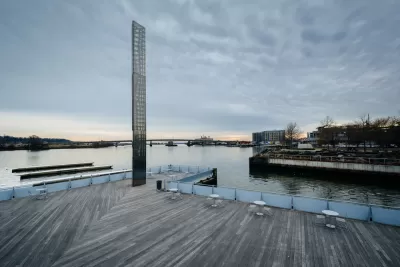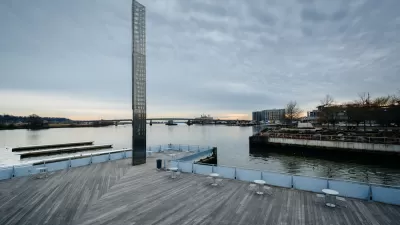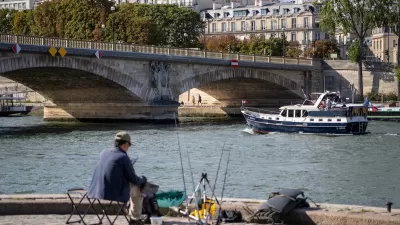The U.S. Army Corps of Engineers could soon study how to legalize swimming in the rivers around the nation’s capital—a scenario that would have seemed impossible in the not-too-distant past.

According to an article by Jacob Fenston, “someday in the not-too-distant future, going for a swim in the District’s rivers could be a real option on a hot summer day.”
“In the latest step toward making swimming in the city possible, the U.S. Army Corps of Engineers will conduct a feasibility study, identifying areas on the Potomac and Anacostia rivers where it’s clean enough and safe enough to swim,” according to Fenston. The study is contingent on President Joe Biden signing the Congress-approved 2022 Water Resources Defense Act.
The possibility of the Potomac and Anacostia rivers being clean enough for swimming first made the Planetizen newsfeed in 2018, when the grades for water quality, granted by local advocates, first crossed into passing territory for both rivers. At the time, the Potomac River’s grade was a B, and the Anacostia a D-. In 2020, the most recent grade for the Potomac River, the grade had slipped slightly to a B-. Unfortunately, the grade for the Anacostia had slipped back into fail territory. So, the efforts of the Army Corps of Engineers will be a welcome addition to the clean up effort.
The Potomac Riverkeepers launched a campaign earlier this year, documented in another article by Fenston, to legalize swimming in the Potomac River for the first time in 50 years.
Local advocates note that people are already going in the water around D.C., but formal legalization would help clear the way for recreational locations devoted to swimming.
FULL STORY: Splash! Army Engineers To Study Possible Swimming Beaches On D.C.’s Rivers

Study: Maui’s Plan to Convert Vacation Rentals to Long-Term Housing Could Cause Nearly $1 Billion Economic Loss
The plan would reduce visitor accommodation by 25,% resulting in 1,900 jobs lost.

North Texas Transit Leaders Tout Benefits of TOD for Growing Region
At a summit focused on transit-oriented development, policymakers discussed how North Texas’ expanded light rail system can serve as a tool for economic growth.

Why Should We Subsidize Public Transportation?
Many public transit agencies face financial stress due to rising costs, declining fare revenue, and declining subsidies. Transit advocates must provide a strong business case for increasing public transit funding.

How to Make US Trains Faster
Changes to boarding platforms and a switch to electric trains could improve U.S. passenger rail service without the added cost of high-speed rail.

Columbia’s Revitalized ‘Loop’ Is a Hub for Local Entrepreneurs
A focus on small businesses is helping a commercial corridor in Columbia, Missouri thrive.

Invasive Insect Threatens Minnesota’s Ash Forests
The Emerald Ash Borer is a rapidly spreading invasive pest threatening Minnesota’s ash trees, and homeowners are encouraged to plant diverse replacement species, avoid moving ash firewood, and monitor for signs of infestation.
Urban Design for Planners 1: Software Tools
This six-course series explores essential urban design concepts using open source software and equips planners with the tools they need to participate fully in the urban design process.
Planning for Universal Design
Learn the tools for implementing Universal Design in planning regulations.
City of Santa Clarita
Ascent Environmental
Institute for Housing and Urban Development Studies (IHS)
City of Grandview
Harvard GSD Executive Education
Toledo-Lucas County Plan Commissions
Salt Lake City
NYU Wagner Graduate School of Public Service





























